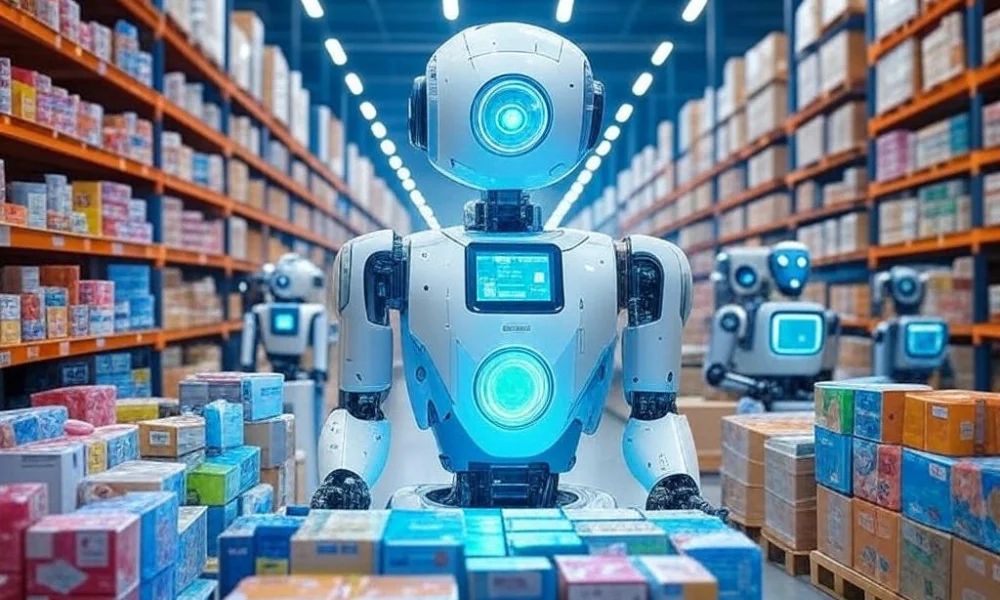Artificial Intelligence
AI Technologies in Warehouse Automation:
AI technologies in warehouse automation are changing the way warehouses operate across the United States. From faster picking to smarter inventory tracking, I explore how these tools improve efficiency and cut costs.

The way things change today, I have seen how much e-commerce has affected everything nearby. Now, getting your orders delivered can happen in no time. Yet, every speedy delivery is possible only because a warehouse is doing its best. Most people are not aware of how much pressure warehouse teams now handle.
Definition:
Automation in the warehouse makes use of robotics and artificial intelligence to complete work that people once performed by hand.
At this point, artificial intelligence is going much deeper. AI is helping to turn simple storage spaces in warehouses into intelligent systems that can learn on their own. The warehouse Automation benefits we gain from these changes are also related to greater accuracy, safety, and smart decision-making.
For this reason, I’m preparing this article. I will outline how AI is support warehouses across the country. AI is changing how goods are handled in logistics, and whether you’re managing a warehouse or simply interested, you’ll find out how.
Rise of Smart Warehousing:
- I have seen that standard warehouses struggle to handle current speedy demands in shipping. Clearly, what we used to do doesn’t cut it anymore. There are many problems to notice, from selecting wrong items to losing time with shipments.
- I found it interesting that AI helps solve real problems successfully. Smart warehousing means more than a trend, it’s a major change. I’ve found that automation helps reduce errors, keeps things moving smoothly, and helps teams concentrate on what matters most.
- Now, warehouses keep going almost all the time, yet there are fewer workers and even more orders to process. I think only businesses with smart systems can stay ahead in the market. When there aren’t enough workers or demand increases, AI can make things easier for managers.
What Exactly Are AI Technologies Leading the Way in Warehouse Automation?
When I began studying AI in warehousing, I wasn’t sure how many impressive AI tools were involved behind the scenes. Each one of these technologies contributes something unique to the way things are run.
Main types I’ve found are described below.
Computer Vision:
Robots can now use computer vision to see what items are in front of them and check for damage right away. It gets rid of the need to check everything manually.
Machine Learning:
Using machine learning, systems can spot patterns from past inventory and estimate what inventory is likely to be needed in the future. Its system allows shelves to stay full, but not overflowing.
Robotic Process Automation (RPA):
I rely on RPA to take care of basic office jobs by processing orders and updating our systems. It saves you time to focus on vital tasks.
Natural Language Processing (NLP):
Warehouse workers can communicate with systems by speaking to them using NLP. It’s useful when I can’t use my hands yet still have to make a choice.
Autonomous Robots and Vehicles:
Such machines are capable of moving about a warehouse freely and without bumping into anything. I’m always amazed when I witness how quickly they can divert themselves on the road.
All of these AI systems are collaborating to boost warehouse performance and safety, improving things more than they have ever been before.
How Does AI Help with Managing Inventory?
- Whenever I worked with old systems, I always found it stressful to handle inventory tracking. Products became absent, wrong quantities were recorded, and organizing inventory was guesswork. However, AI fixed that problem for me.
- AI helps us track the location of every product with the help of real-time sensors and RFID tags. Any time inventory is used, these tools update the current stock. Late-night counting and sudden shortages are now things from the past.
- System is able to predict when stock will run low for each product. I’ve used the information to schedule restocks and prevent my shelves from being low. Not only does it save us time, but it also lowers costs and makes customers pleased.
What Impact Is AI Having on Picking and Packing?
- I once thought picking and packing just meant grabbing some packages and sealing them. Yet, my view changed completely through AI. Now, the system chooses the best way to deal with every order.
- AI robots can teach themselves not to damage things by gripping them. They know exactly which shape or size to pick, no matter which one their target uses. It operates faster and safer than if the same job were handled by a human team alone.
- With AI, you can find out the best way to organize items inside a box. I’ve noticed that this saves money on shipping and provides better product protection. Outcome leads to higher customer happiness and less need for returns.
How Does Artificial Intelligence Help with Running Warehouses?
- I began to question if using AI in warehouses would actually offer real benefits. After observing it, I think the rewards are huge.
- First, operations have become more efficient and shown less mistakes. Because of AI, fewer errors occur in both inventory and picking, resulting in fewer complaints from shoppers. It lets me concentrate on moving the business forward rather than fixing issues.
- In addition, AI can save your business money over the long run. Even with a high startup cost, I have observed companies find ways to use less labor and make better use of their workspace. Doing more with less is now possible in warehouses, and that’s a real breakthrough.
- In addition, I’ve seen that AI improves safety and makes workers happier. Robotics helps humans accomplish tough tasks more quickly. As a result, both workers and the team experience less risk and more safety.
What Difficulties Are There When Using AI in Warehouses?
- Whenever I talk to colleagues, a lot of them ask if AI in warehouses causes any issues. Yes, they can be issues,but they’re not always serious.
- Largest difference I notice is the change in price. I’ve noticed that many small businesses have difficulty buying AI tools at first. Creating a brand takes both energy and money before any results are seen.
- Another issue is integration. A lot of older systems are not designed to work well with newer AI platforms. I’ve been in this situation too, and not having a plan ahead can make things slower for you.
- There’s also the human side. There are workers who are scared that automation will put them out of work. I am more concerned with how AI affords support to teams, rather than how it might replace them. I know that it’s a controversial subject.
Who Is Using AI to Make a Difference in Warehouse Operations?
- I’m amazed at how some warehouses have completely adopted AI to modify their work processes. Amazon is different because its Kiva robots pick shelves and bring them to workers without them having to get up from their stations. The way work is done has been greatly improved by its efficiency.
- Ocado makes use of a robotic system that helps robots handle picking and packing items to the greatest level of accuracy. I think their approach is quite effective when handling extensive orders.
- The company has also added robots that are powered by AI to check and fill store shelves. As a result, we avoid out-of-stock situations, since I know they bother the customers.
- Many small businesses are now involved, too. Multiple people use third-party service providers that have AI application for less upfront money. This seems to me like a great opportunity for more.
Where Is AI Going in the Future for Warehousing?
- The direction warehousing takes will be guided by the progress of AI over the coming years. It’s clear to me that people will collaborate more closely with AI in years to come. Crystal AI tools will empower workers by giving them easier ways to work, rather than taking away their roles.
- Autonomous decision-making will also grow. I picture warehouses where AI does not need humans to help it solve complicated problems. This will further accelerate how things get done.
- AI will also affect the field of sustainability. I’m eager for AI to support warehouses in decreasing energy needs and packing more efficiently. It means you can operate more sustainably while saving cash and helping out the environment.
Conclusion:
I’ve noticed that AI is making warehouses both more effective and smartly managed. The use of AI in warehouses enhances their capabilities, ensuring they can serve more customers and handle rising levels of orders. I believe any business that includes AI in their strategies will be the leaders in the logistics industry. If you are connected to warehouses, AI knowledge can help you lead the field.How do you think warehouse work is being affected by the use of AI?What issues do you expect warehouses to encounter when using AI?Are AI tools suitable for improving your warehouse or supply chain?
-

 Artificial Intelligence8 months ago
Artificial Intelligence8 months agoHow to Use Grok AI: A Complete Guide
-

 Artificial Intelligence10 months ago
Artificial Intelligence10 months agoWhat is Artificial Intelligence? A Comprehensive Guide for Businesses and Enthusiasts
-

 Artificial Intelligence9 months ago
Artificial Intelligence9 months agoUnlocking the Power of Artificial Intelligence Tools
-

 Artificial Intelligence9 months ago
Artificial Intelligence9 months agoWhat is DeepSeek? Revolutionizing AI with Cutting-Edge Solutions
-

 Artificial Intelligence5 months ago
Artificial Intelligence5 months agoPredictive Analytics for Demand Forecasting:
-

 Artificial Intelligence6 months ago
Artificial Intelligence6 months agoMeta’s AI Push: The Standalone Assistant App Set to Rival ChatGPT
-

 Artificial Intelligence5 months ago
Artificial Intelligence5 months agoHow Artificial Intelligence is Revolutionizing Logistics:
-

 Artificial Intelligence8 months ago
Artificial Intelligence8 months agoWhat is Grok AI? A Game-Changing Chatbot with Real-Time Insights


